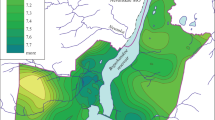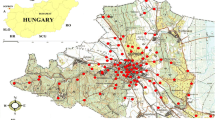Abstract
Physicochemical and biological properties of urbanized soils in the city of Mariupol have been considered in comparison with the background soils. The parametrical characteristics (abundance and biomass) of soil algal groups, the content of humus, the reaction of soil solution, the content of heavy metals, and the particle size distributions of soils under different anthropogenic impacts have been assessed. The physicochemical properties of soils developing under urboecosystem conditions affect the number of structure-forming species, biomass, and proportions of soil algae. According to the particle size distribution, urban soils are classified among the medium and heavy loamy soils with the predominance of the clay and coarse silt fractions. The fractions of physical clay and clay are of highest importance for the existence of algae. The accumulation of heavy metals in the surface horizons of soils can stimulate or inhibit the development of algae depending on the metal concentration.
Similar content being viewed by others
References
E. V. Arinushkina, Handbook on the Chemical Analysis of Soils (Moscow State University, Moscow, 1970) [in Russian].
O. O. Baranova, Algae of Ore Mining Dump Fields and Toxic Waste Dumps (Lyuks, Melitopol, 2012) [in Ukrainian].
V. N. Bashkin, A. S. Kurbatova, and D. S. Savin, Methods of Assessment of Maximum Loads of Pollutants on Urban Ecosystems (Urban Environment Research and Design Institute, Moscow, 2004) [in Russian].
Y. N. Vodyanitskii and A. S. Yakovlev, “Assessment of soil contamination by the content of heavy metals in the soil profile,” Eurasian Soil Sci. 44 (3), 297–303 (2011).
M. I. Gerasimova, M. N. Stroganova, N. V. Mozharova, and T. V. Prokof’eva, Anthropogenic Soils: Genesis, Geography, and Reclamation (Oikumena, Smolensk, 2003) [in Russian].
V. V. Egorov, V. M. Fridland, E. N. Ivanova, et al., Classification and Diagnostics of Soils of the Soviet Union (Kolos, Moscow, 1977) [in Russian].
D. G. Zvyagintsev, I. P. Bab’eva, and G. M. Zenova, Biology of Soils (Moscow State University, Moscow, 2005) [in Russian].
R. R. Kabirov, Use of Algae as the Test and Indication Microorganisms (Bashkir Pedagogical Institute, Ufa, 1995) [in Russian].
N. A. Kachinskii, Mechanical and Microaggregate Structure of Soil and Its Analysis Methods (Academy of Sciences of the Soviet Union, Moscow, 1958) [in Russian].
G. G. Kuzyakhmetov and I. E. Dubovik, Analysis of Soil Algae (Bashkir State University, Ufa, 2001) [in Russian].
D. V. Ladonin and O. V. Plyaskina, “Isotopic composition of lead in soils and street dust in the Southeastern administrative district of Moscow,” Eurasian Soil Sci. 42 (1), 93–104 (2009).
I. A. Mal’tseva, “Soil algae from Velikomikhailovskii forest massif (Dnepropetrovsk oblast),” 5 (1–2), 66–72 (2004).
I. A. Mal’tseva, Soil Algae from the Forests of Steppe Ukraine (Lyuks, Melitopol, 2009) [in Ukrainian].
I. A. Mal’tseva, Yu. P. Adamenko, T. I. Zhoglo, Z. G. Pisanets, and E. I. Mal’tsev, “Influence of lead and cooper abundance on soil algae,” Ekol. Noosferol. 19 (1–2), 125–128 (2008).
E. A. Martynova, Candidate’s Dissertation in Biology (Dnepropetrovsk, 1989).
V. V. Medvedev, “Physical properties and spatial distribution of the plowpan in different arable soils,” Eurasian Soil Sci. 44 (12), 1364–1372 (2011).
Yu. L. Meshalkina and V. P. Samsonova, Mathematical Statistics in Soil Sciences: Practical Manual (MAKS Press, Moscow, 2008) [in Russian].
Methodological Recommendations for Determination of Microconcentrations of Pesticides in Food, Fodder, and Environment (Moscow, 1987), No. 15.
Methodological Recommendations No. 968-79: Maximum permissible concentrations of chemicals in soil. A method of polarographic analysis of lead in soil, 1968.
O. P. Myagchenko, Ecology of Northern Azov Sea Region (VPK, Zaporozhye, 1999) [in Ukrainian].
A. D. Temraleeva, D. L. Pinskii, E. V. Spirina, and E. N. Patova, “The use of algae-cyanobacterial communities for the assessment of lead pollution of gray forest soils,” Eurasian Soil Sci. 44 (3), 326–331 (2011).
S. Ya. Trofimov and E. I. Karavanova, Fluid Phase of Soils (Moscow State University, Moscow, 2009) [in Russian].
A. I. Fateev, Ya. V. Pashchenko, S. A. Blyuk, et al., Background Concentration of Microelements in Ukrainian Soils, Ed. by A. I. Fateev and Ya. V. Pashchenko (Ukrainian National Academy of Sciences, Kharkov, 2003) [in Ukrainian].
F. I. Khakimov, N. F. Deeva, and A. O. Il’ina, “Urban soils: transformation and pollution,” Ekol. Noosferol. 17 (1–2), 24–40 (2006).
T. M. Chornevich, I. A. Mal’tseva, and V. A. Nikorich, “Soil algae of coniferous forests of Ukraine,” Ekol. Noosferol. 19 (3–4), 77–82 (2008).
O. G. Shekhovtseva, “Transformation of organic matter as the ecological indicator of disturbed balance in soils of Zaporozhye urban ecosystems,” Visn. Zaporozh. Nats. Univ., Biol. Nauki, No. 2, 106–110 (2010).
O. G. Shekhovtseva, “Biological activity of urban soils (by example of Mariupol),” Gruntoznavstvo 12 (1–2), 88–91 (2011).
E. A. Shtina and M. M. Gollerbakh, Ecology of Soil Algae (Nauka, Moscow, 1976) [in Russian].
E. A. Shtina, G. M. Zenova, and N. A. Manucharova, “Algological monitoring of soils,” Pochvovedenie, No. 12, 1449–1461 (1998).
A. S. Yakovlev and M. V. Evdokimova, “Ecological standardization of soil and soil quality control,” Eurasian Soil Sci. 44 (5), 534–546 (2011).
E. G. Bellinger and D. C. Sigee, Freshwater Algae: Identification and Use as Bioindicators (Wiley, Chichester, UK, 2010).
J. R. Jonansen and L. E. Shubert, “Algae in soils,” Nova Hedwigia Beihefi. 123, 297–306 (2001).
J. C. Radway, E. W. Wilde, M. J. Whitaker, and J. C. Weissman, “Screening of algal strains for metal removal capabilities,” J. Appl. Phycol., No. 13, 451–455 (2001).
S. M. Reichman, The Responses of Plants to Metal Toxicity: A Review Focusing on Copper, Manganese, and Zinc (Australian Minerals and Energy Environment Foundation, Melbourne, 2002).
Author information
Authors and Affiliations
Corresponding author
Additional information
Original Russian Text © O.G. Shekhovtseva, I.A. Mal’tseva, 2014, published in Pochvovedenie, 2014, No. 7, pp. 869–877.
Rights and permissions
About this article
Cite this article
Shekhovtseva, O.G., Mal’tseva, I.A. Physical, chemical, and biological properties of soils in the city of Mariupol, Ukraine. Eurasian Soil Sc. 48, 1393–1400 (2015). https://doi.org/10.1134/S1064229315120145
Received:
Published:
Issue Date:
DOI: https://doi.org/10.1134/S1064229315120145




